Barbara Kruger
News

Barbara Kruger on ARTSY.NET
10 November 2018
Review by Alina Cohen Barbara Kruger Revisits a 40-Year-Old Series That’s as Relevant as Ever on ARTSY.NET.
This month, Mary Boone Gallery is showcasing 14 Barbara Kruger artworks that are all celebrating their 40th anniversary. The show is an invitation to reflect on what’s changed—and what hasn’t—across American politics since 1978.
Notably, the “Untitled (Body)” series at Mary Boone diverges from the aesthetic Kruger is best known for today. The artist is inevitably associated with her stark black, white, and red silkscreens that merge found imagery with phrases rendered in bold Futura typeface. In iconic works such as Untitled (I shop therefore I am) (1987) and Untitled (Your body is a battleground) (1989), Kruger ironically condemned consumer consumer culture and American society’s treatment of women.
While different in style, Kruger’s 1978 works are part of her larger conceptual endeavors. Throughout her career, she’s appropriated text and imagery, or taken it from existing sources, to create new associations and ideas. Though Kruger rejects the term “political art,” it’s impossible to look at the Mary Boone show without sensing deep convictions about the state of America. Her project isn’t bound to a particular time or issue. Instead, her juxtapositions of pictures and words generate new perspectives on the language and images we’re sold everyday—by the media, advertisements, corporations, and the government. As technology allows for ever-greater pictorial and informational bombardment, Kruger’s work only becomes more relevant...
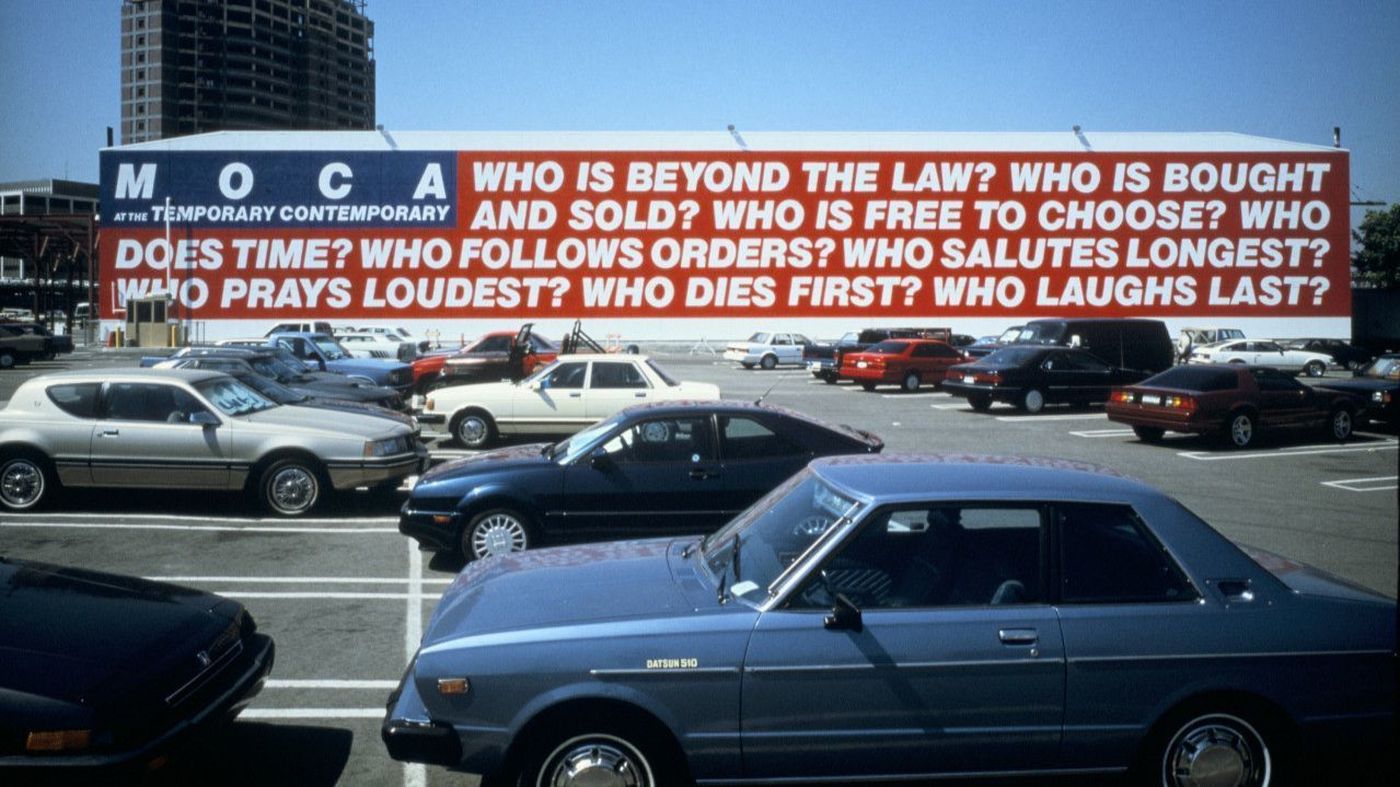
Barbara Kruger in the Los Angeles Times
18 October 2018
Article by Carolina A. Miranda In advance of midterms, Barbara Kruger reprises MOCA mural that asks 'Who is beyond the law?' in the LOS ANGELES TIMES.
There are more iconic years: 1945, which marked the end of a world war, and 1968, with its roiling protest movements. But 1990 also marked an important social and political moment. The Soviet Union was falling apart. HIV became one of the top 10 causes of death in the United States. And the U.S. was heading toward a war with Iraq — the first one, led by President George H.W. Bush.
“It was Bush 1 and everyone was wearing flags,” recalls artist Barbara Kruger. “And, omigod, the war. It was just horrific.”
It was in that climate that the artist painted a mural on the south facade of what was then known as the Temporary Contemporary, the Little Tokyo branch (now known as the Geffen Contemporary) of the Museum of Contemporary Art Los Angeles. The nearly three-story-high mural, in ways both oblique and direct, tackled issues of power, corruption, gender and race.
In its design, the mural “Untitled (Questions)” was inspired by the U.S. flag. Except that in lieu of stripes, it featured nine questions rendered in grab-you-by-the-eyeballs capital letters: “WHO IS BEYOND THE LAW? WHO IS BOUGHT AND SOLD? WHO IS FREE TO CHOOSE? WHO DOES TIME? WHO FOLLOWS ORDERS? WHO SALUTES LONGEST? WHO PRAYS LOUDEST? WHO DIES FIRST? WHO LAUGHS LAST?”
The piece remained in place for two years — well into 1992, when it served as backdrop to the Los Angeles riots...

Barbara Kruger in Art Basel Cities
6 September to 12 September 2018
Site-specific painted mural Untitled (No puedes vivir sin nosotras / You can’t live without us) for exhibition Hopscotch (Rayuela) presented by Art Basel Cities, Puerto Madero, Buenos Aires, Argentina.
Barbara Kruger is an American artist who works with pictures and words. Known for her pointed social commentary, she has created a site-specific installation that integrates text-based murals into the Buenos Aires cityscape. Untitled (No puedes vivir sin nosotras / You can't live without us) is a large-scale mural painted in the colors of the Argentinian flag covering an abandoned grain silo in Puerto Madero. Standing directly in view of Santiago Calatrava’s Puente de la Mujer, the mural reads (in Spanish), “You can’t live without us / power / pleasure / property / equality / empathy / independence / doubt / belief / women.” Below, it asks: “Who owns what?” Behind the silos are the Parque Mujeres Argentinas, which was dedicated to the women of Argentina in 2007 after decades of civic near-invisibility, while the neighboring streets commemorate major female figures like Juana Manso, Marta Lynch, and Manuela Sáenz. The forceful – yet hopeful – emblazoning of such a message onto the very face of the city continues Kruger’s commitment to feminist themes and offers solidarity to the country’s active women’s movement.
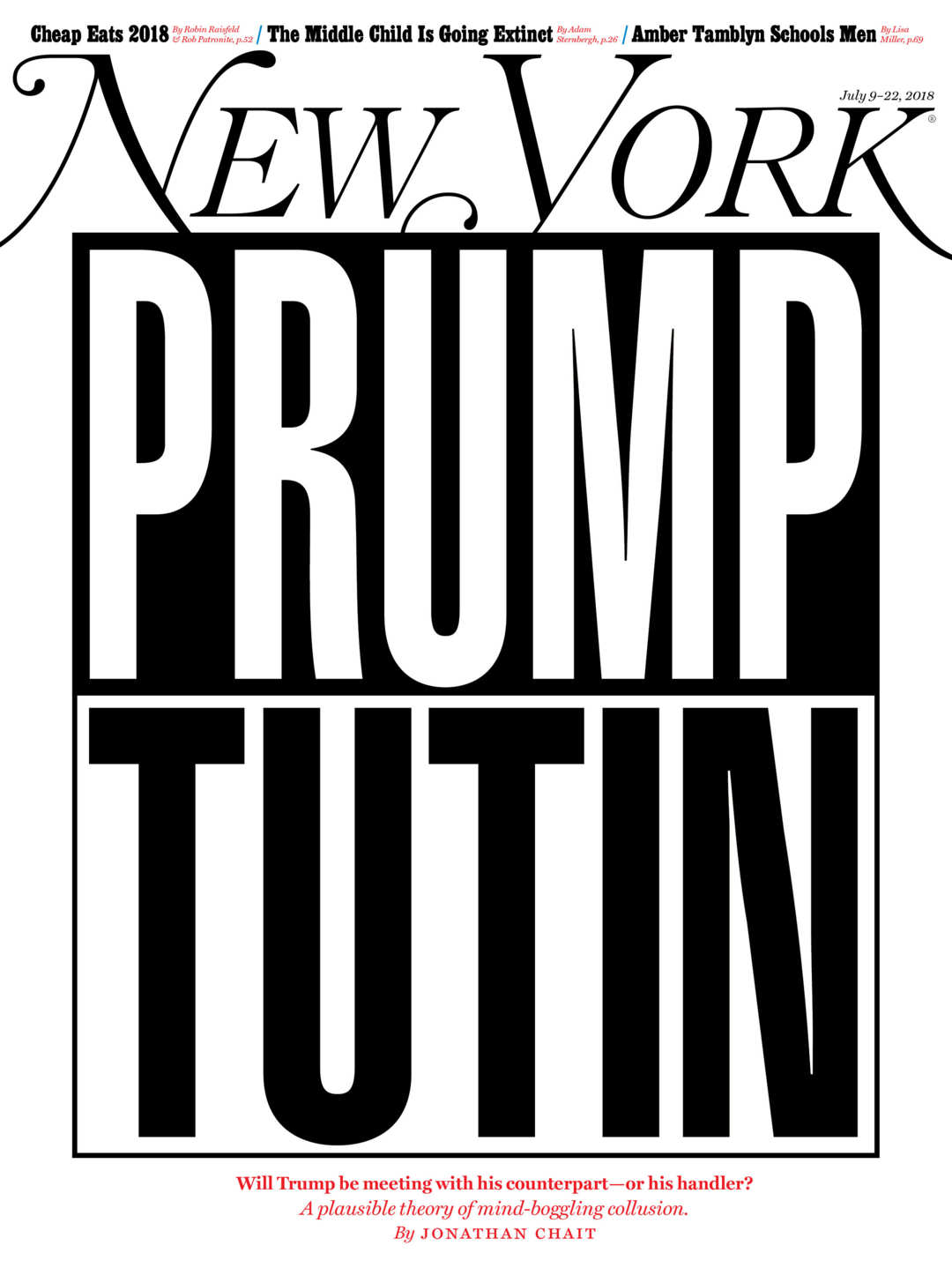
Barbara Kruger Cover for New York Magazine
9 July to 22 July 2018
Cover and Illustration for Cover Story by Jonathan Chait Will Trump Be Meeting With His Counterpart — Or His Handler? for NEW YORK MAGAZINE 9 July to 22 July 2018.
On June 14, 2016, the Washington Post reported that Russian hackers had broken into the Democratic National Committee’s files and gained access to its research on Donald Trump. A political world already numbed by Trump’s astonishing rise barely took notice. News reports quoted experts who suggested the Russians merely wanted more information about Trump to inform their foreign-policy dealings. By that point, Russia was already broadcasting its strong preference for Trump through the media. Yet when news of the hacking broke, nobody raised the faintest suspicions that Russia wished to alter the outcome of the election, let alone that Trump or anybody connected with him might have been in cahoots with a foreign power. It was a third-rate cyberburglary. Nothing to see here...

Barbara Kruger at LAXART
3 June to Fall 2018
Site-specific installation for LAXART, Los Angeles, California.
Barbara Kruger is yelling. In an extraordinary new Hollywood mural, the artist who is known for often blunt, declarative works that use plain language and sharp graphic design in ruminative ways has amped up the rhetoric.
Good for her. American society’s doomsday clock is ticking, and not only in a nuclear sense. Welcome her shouts.
At LAXART, the independent nonprofit venue that has just revamped its exhibition space, Kruger commandeers the otherwise modest building’s façade at a much-traveled corner on Santa Monica Boulevard. In mostly black, uppercase, sans serif typeface, poetic rat-a-tat-tat grabs passersby on foot or wheels.
When it comes to ordinary street signage for a pizzeria or muffler shop, we’re used to something more playful or beguiling than “break it, own it, steal it, loan it, kiss it, slap it, hug it, hurt it.” Kruger’s printed verb commands are like the frieze on a classical temple’s entablature; they’re held aloft by fat vertical “columns” between blocked-out windows.
Holding up the abusive orders, the columns’ white words on a black background sputter motivations: “pleasure, power, profit, property, poverty.” Rising from beneath the windows across a podium painted vivid green, foundational words demand: “privatize, monetize, moralize, terrorize.”...
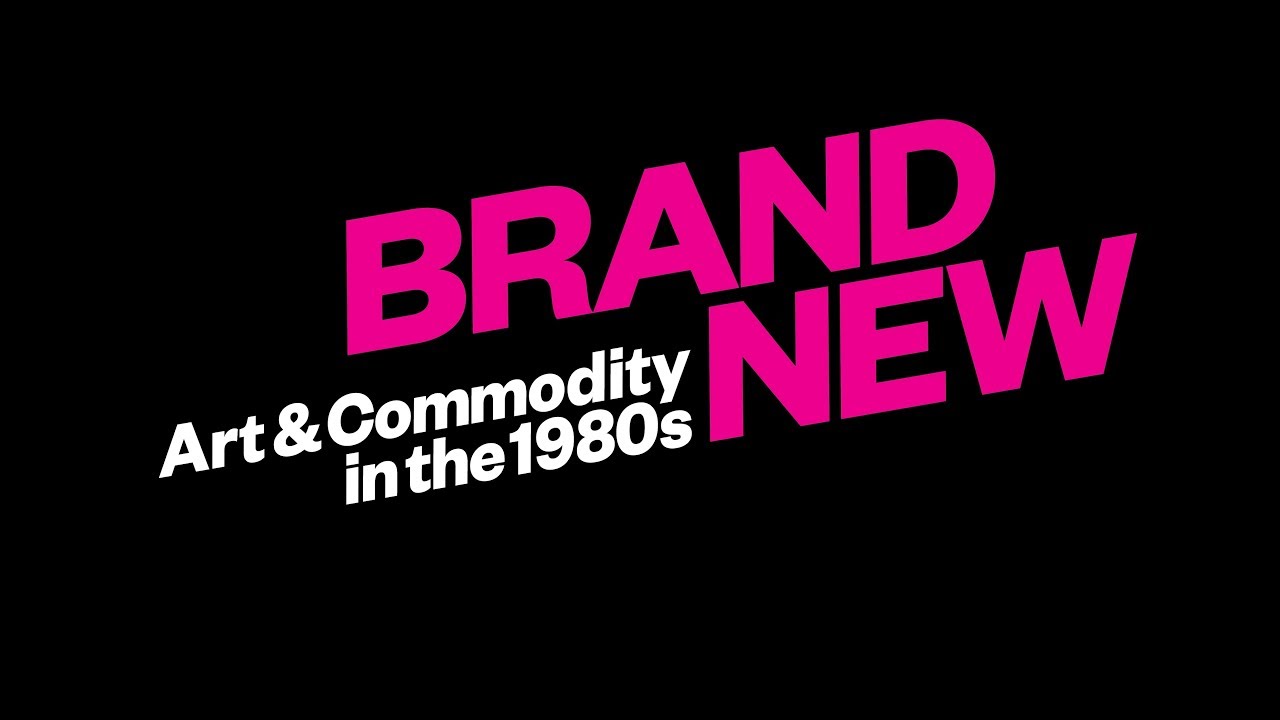
Barbara Kruger at the Hirshhorn Museum and Sculpture Garden
14 February to 13 May 2018
Included in group exhibition Brand New: Art and Commodity in the 1980s at the Hirshhorn Museum and Sculpture Garden, Washington, DC.
It’s the 80s as you’ve never seen it before. Explore the iconic decade when artwork became a commodity and the artist, a brand. Razor-sharp, witty, satirical and deeply subversive, these nearly 150 works examine the origins and rise of a new generation of artists in 1980s New York who blurred the lines between art, entertainment and commerce, a shift that continues to define contemporary art today.
Thirty years ago, seismic shifts in politics, economics and technology brought about a golden era of contemporary art in the United States, particularly in New York City, with its heady Wall Street wealth and gritty streets.
Brand New offers a fascinating alternative history of art in the 1980s by tracing how a pioneering group of young downtown artists appropriated the tools and psychology of growing consumer culture—advertising, logos, products, even cable TV—to change the landscape of the art world. Manufactured objects, such as vacuum cleaners and clocks, became vessels with complex meanings. Advertising and television emerged as rich new mediums for expression, and artworks themselves became branded products. Like today’s celebrity influencers, artists crafted branded personas to both market themselves and as a form of creative expression...
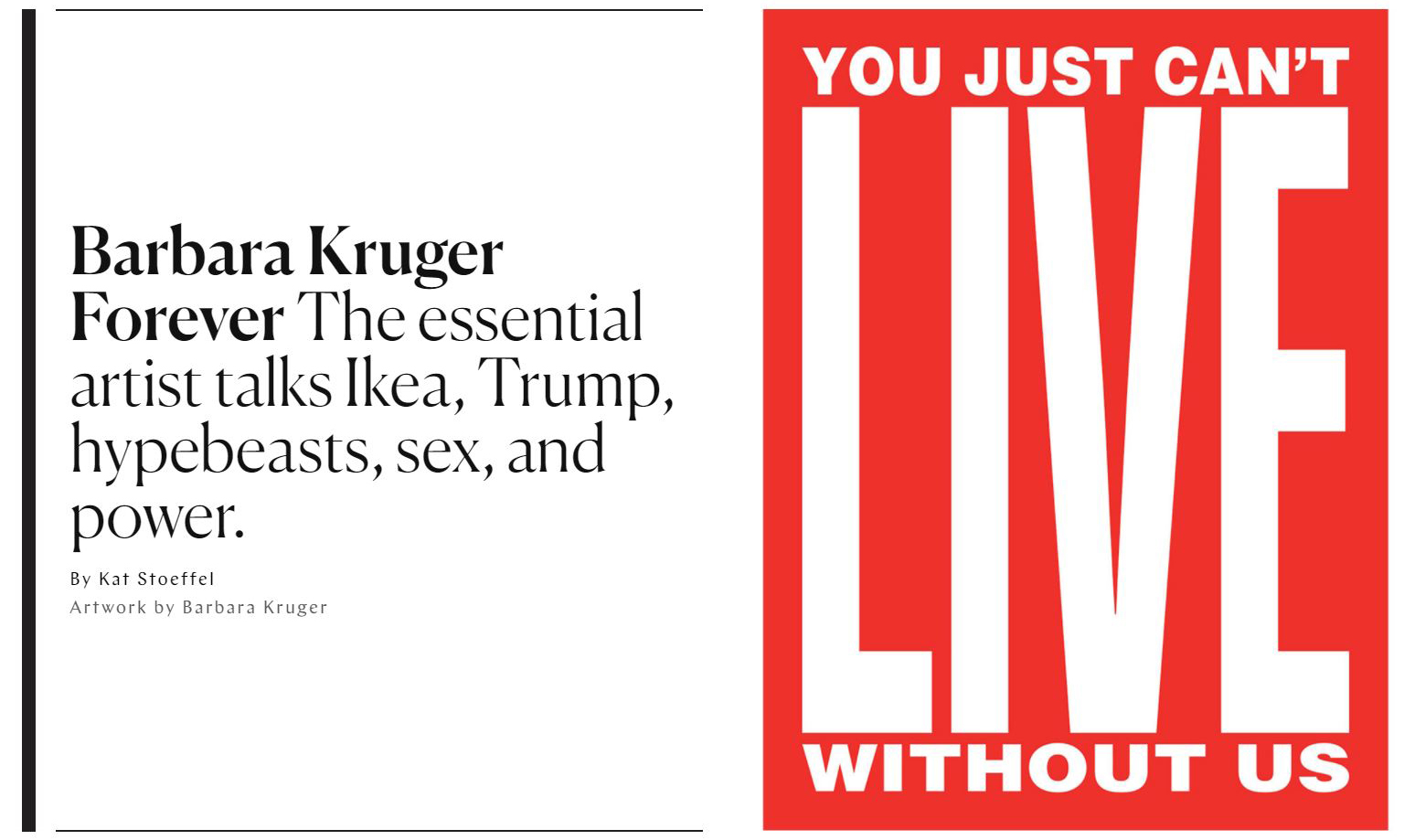
Barbara Kruger in New York Magazine
2 February 2018
Profile by Kat Stoeffel Barbara Kruger Forever: The essential artist talks Ikea, Trump, hypebeasts, sex, and power. for The Cut in New York Magazine.
I met artist Barbara Kruger on the day after Christmas: the fourth-biggest shopping day of 2017 and one of the coldest. “They’re returning things already,” she said, gesturing toward the bundled figures hustling past an Upper West Side Le Pain Quotidien. Kruger would beat the worst of the cold snap, flying to Los Angeles, where she teaches at UCLA and lives half the year. Her Boxing Day errand was to mail some books to herself there.
Kruger is best known for text and image pieces that prompt you to assess your relationship to consumerism — “I shop therefore I am” and “You want it. You buy it. You forget it.” — although her nearly 50-year CV covers many isms across many media. Her background is in magazine design, and perhaps as a result, her work is eye-catching, easily transmitted, and frequently ripped off. It’s a phenomenon that both amuses and inspires her. In 2011, she made a wall piece collaging hundreds of Kruger look-alikes that she found on the internet, and in November, she staged her first-ever performance: a flash sale of Barbara Kruger merch modeled after a “drop” from Supreme, the skatewear brand whose logo mimics the white-Futura-on-red text treatment that she layers over black-and-white photographs...
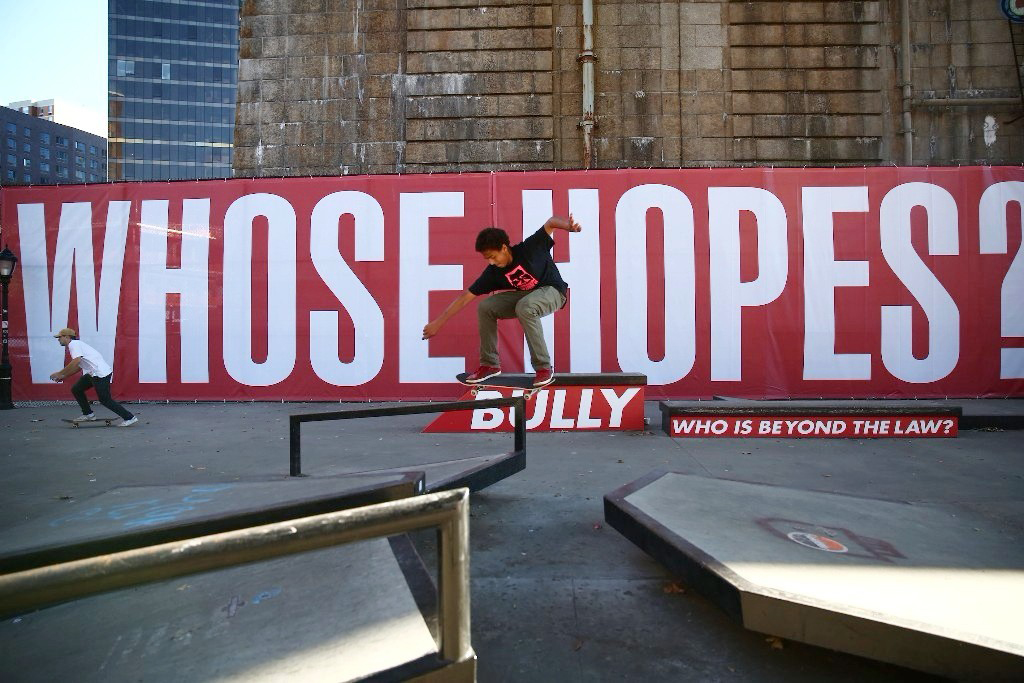
Barbara Kruger on Art21
24 January 2018
Featured in short film Part of the DIscourse on Art21.
While sharing her earliest influences and what led her to become an artist, Barbara Kruger explains the origins of her 2017 Performa commission, Untitled (Skate), a site-specific installation at Coleman Skatepark in New York City’s Lower East Side. Growing up in a working class family in Newark, New Jersey before landing a job as a designer for Condé Nast publications, Kruger considers how her design experience lent a fluency and directness to the development of her text-driven work...
“Money talks. Whose values?” says Kruger, quoting some of the panels installed in the skatepark. “These are just ideas in the air and questions that we ask sometimes—and questions that we don’t ask but should ask.”
Direct not just in its address of the viewer, but also in its active engagement with social and political events, Kruger’s work uses the visual language of advertising to critique the very messages it emulates. Her work asks viewers to closely consider how global topics like consumerism and power play a role in their daily lives. “Something to really think about is what makes us who we are in the world that we live in.” says the artist. “And how culture constructs and contains us.”
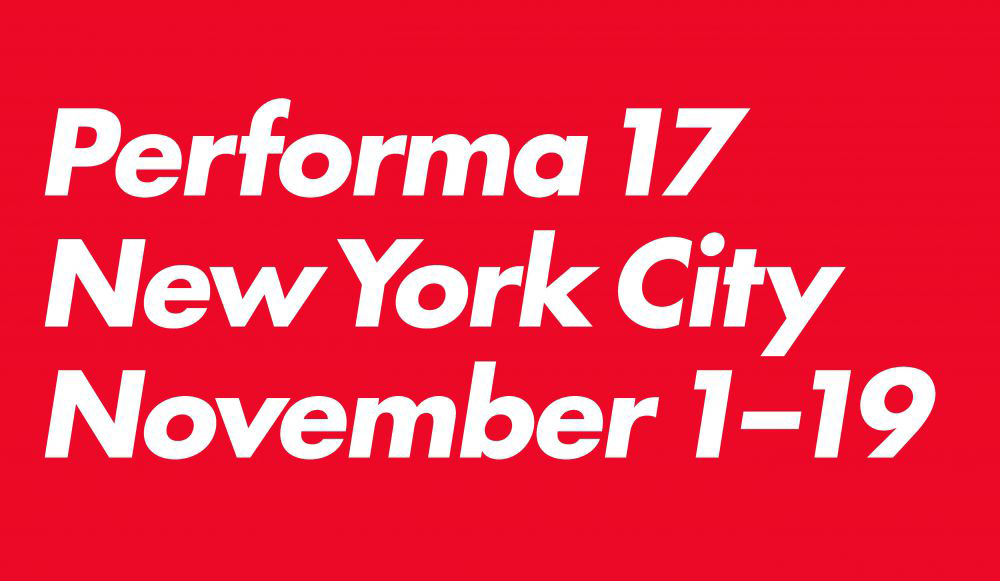
Barbara Kruger in Performa 17
1 November to 19 November 2017
Included in Performa 17 Biennial.
Performa, the internationally acclaimed organization dedicated to live performance across disciplines, announces a major new commission and design collaboration with Barbara Kruger for Performa 17, the seventh edition of the Performa Biennial, to take place November 1–19, 2017, at locations throughout New York City.
Kruger’s Performa Commission will insert the artist into the urban street culture that has absorbed, appropriated, and applied her provocative attitude and approach through a series of public art actions, performances, and installations. Expanding upon her iconic photo-collages combining text and image, Kruger will employ these signature effects and strategies to broadcast messages that engage issues of and ideas about power, desire, adoration, contempt, and capital. Using her instantly recognizable white-on-red Futura typeface, the project will include an installation for the popular Lower East Side skate park located beneath the Manhattan Bridge, created in partnership with NYC Parks and skate park designer Steve Rodriguez; the design of a billboard on 17th Street and 10th Avenue in Chelsea; and a full wrap of a classic school bus that will serve as a mobile site for community engagement. Additional strategic public interventions will be announced closer to the opening of the biennial. These elements will take on New York City, unfolding throughout the duration of Performa 17 to immerse audiences in powerful messages grounded in activism, feminism, and community while exploring the role and power of mass media.

Barbara Kruger in T/The New York Times Style Magazine
15 September 2017
Article by Hilary Moss Barbara Kruger Heads to Berlin, With Virginia Woolf in Tow in T/The New York Times Style Magazine.
During her four-decades-long career, the conceptual artist Barbara Kruger has riffed on the words of Virginia Woolf, returning, time and again, to lines from “Mrs. Dalloway” or “To the Lighthouse.” And for her exhibition “Forever,” opening in Berlin this weekend, Kruger plucked a quotation from Woolf’s extended essay “A Room of One’s Own,” filling an entire gallery wall with: “You know that women have served all these centuries as looking glasses possessing the magic and delicious power of reflecting the figure of man at twice its natural size.”(Kruger appended “you know that,” for the Woolf purists out there.)...
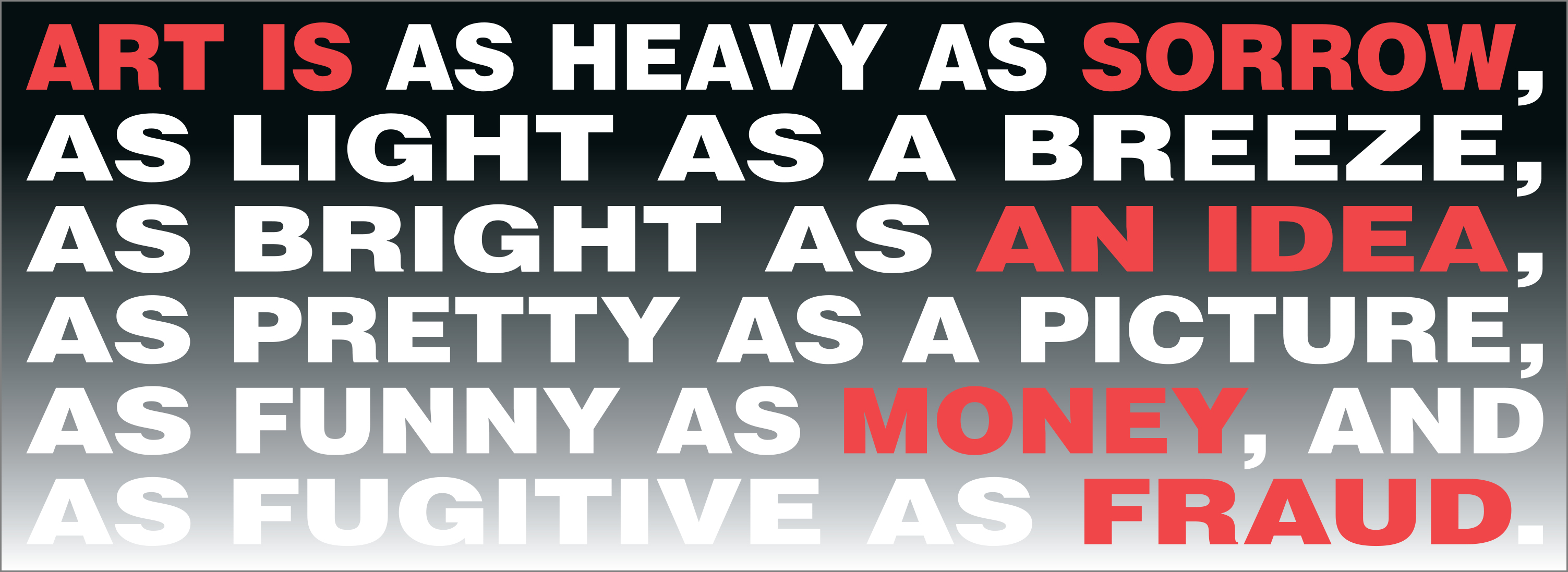
Judith Bernstein, Angela Bulloch, and Barbara Kruger at the Hall Art Foundation
Opening 1 July 2017
Included in group exhibition Für Barbara at the Hall Art Foundation, Schloss Derneburg Museum, Derneburg, Germany.
The Hall Art Foundation is pleased to announce a group exhibition, Für Barbara, to be held at its Schloss Derneburg location in honor of recently deceased gallerist Barbara Weiss. A lifelong advocate for women in the arts, Weiss was also a friend of the Hall's and inspired the inclusion of many works by female artists in the Hall and Hall Art Foundation collections. The exhibition, curated by Leo Koenig, includes over 90 paintings, sculptures, photographs, works on paper and videos by an international and multi-generational roster of female artists dating from the 1950s to 2017...
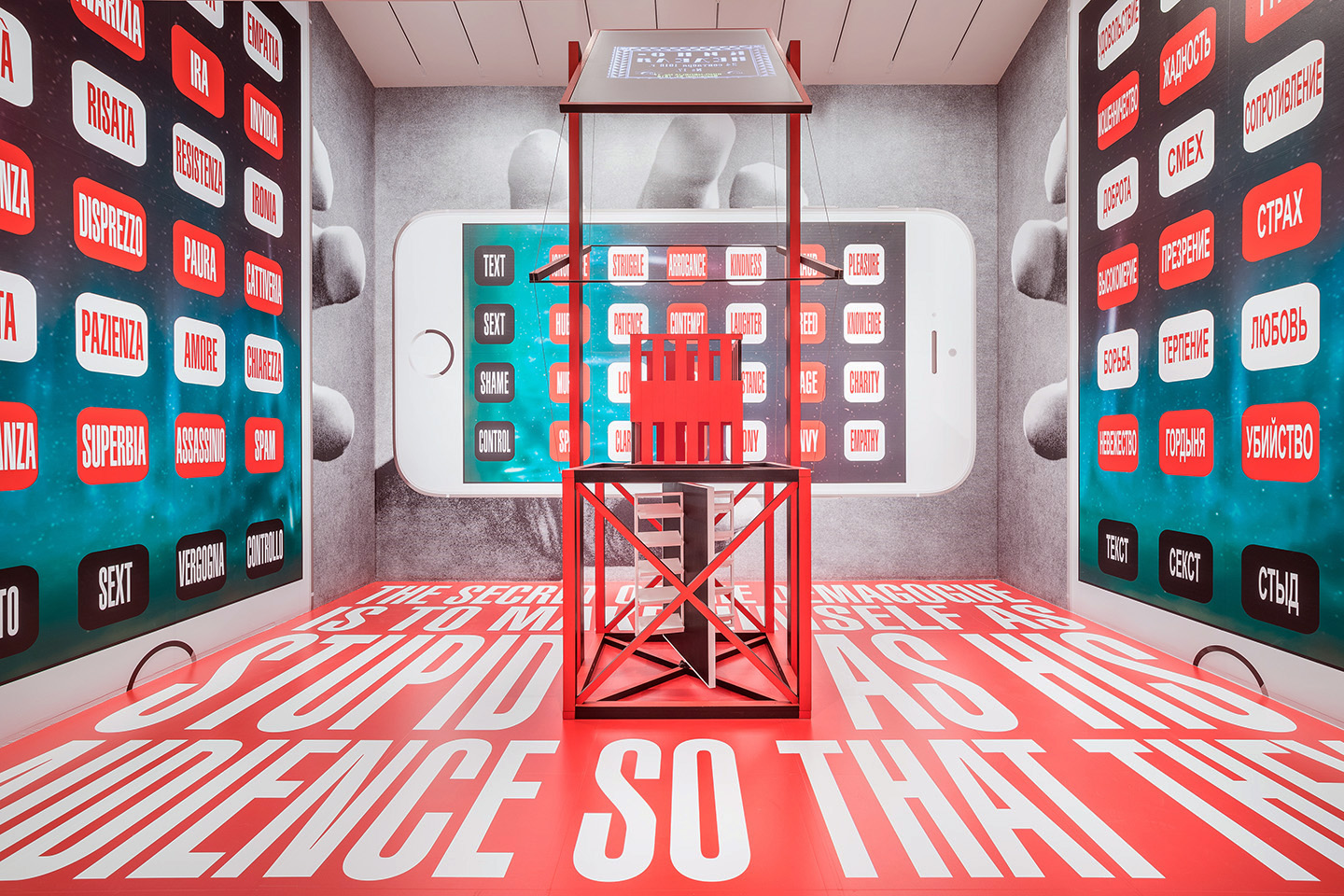
Barbara Kruger at V-A-C Foundation
13 May to 25 August 2017
Included in group exhibition Space Force Construction at V-A-C Foundation, Palazzo delle Zattere, Venice, Italy.
Marking the centenary of the 1917 Russian Revolution, Space Force Construction considers the legacy of early Soviet art and its spaces of display. The exhibition brings together more than 100 works from the 1920s and ‘30s along with major reconstructions of spaces, sculptures and functional objects by key Soviet artists such as El Lissitzky, Gustav Klutsis, Aleksandr Rodchenko and Varvara Stepanova. These recreations and historical art works are brought into dialogue with new commissions and recent works by contemporary visual and performing artists, among them Abraham Cruzvillegas, Melvin Edwards, Janice Kerbel, Irina Korina, Barbara Kruger, Christian Nyampeta, Florian Pumhösl, Wolfgang Tillmans and Mikhail Tolmachev...
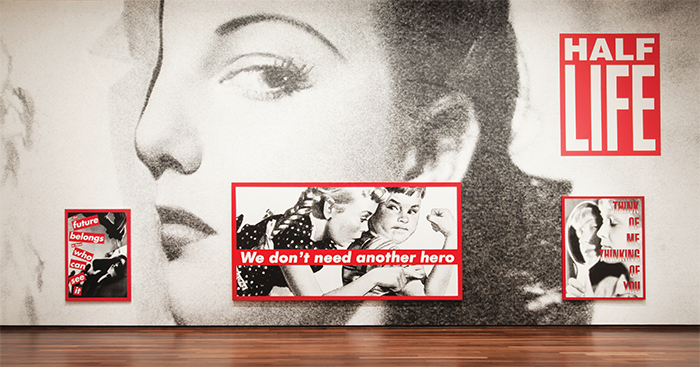
Barbara Kruger in ARTFORUM
February 2017
Review by Bibiana Obler Facing the Nation: Bibiana Obler on Barbara Kruger in Washington in Artforum.
There was something uncanny about the timing of “Barbara Kruger,” which opened at the National Gallery of Art this past September. While ostensibly scheduled to reinaugurate the museum’s series of monographic In the Tower exhibitions on the occasion of the reopening of its newly renovated East Building, the show also spanned the final stretch of the 2016 presidential campaign, the election, and the inauguration. Not that the choice was overtly controversial: Kruger’s searing critiques of the Reagan era are by now so canonical that they have even been absorbed into the AP Art History curriculum. Yet, as installed in the heart of our capital this past fall, Kruger’s strategic juxtapositions of image and text appeared urgently relevant. Indeed, several of the most prominent works could almost have been conceived as campaign posters for the election...
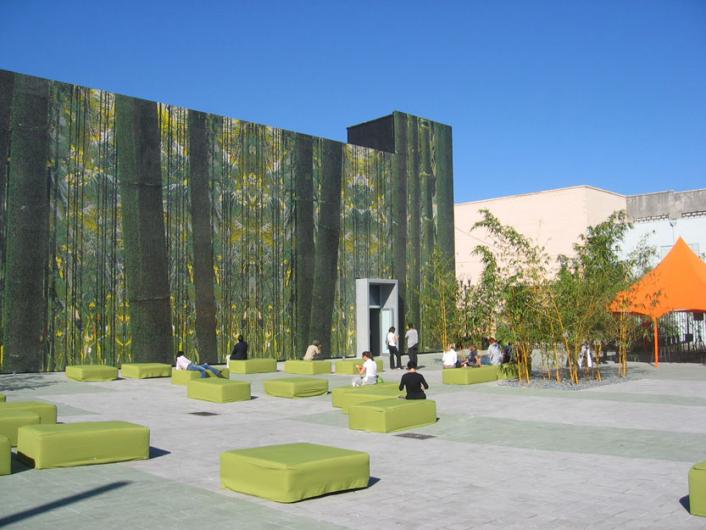
Robert Barry, Barbara Kruger at Cisneros Fontanals Art Foundation
30 November 2016 to 12 March 2017
Included in group exhibition Toda Percepcion es una Interpretacion: YOU ARE PART OF IT at Cisneros Fontanals Art Foundation, Miami, Florida.
The exhibition Toda percepción es una interpretación: You are part of it is a retrospective look from the viewpoint of contemporary issues of art, culture, politics and economics. It seeks to reflect on the successive reconfigurations of the art map in the last few decades, on the displacements and relocations of its primary centers, from Paris to New York, from Venice to São Paulo, from Basel to Miami. It speaks of areas that have succeeded in alternating centripetal or centrifugal forces, where art has relocated its meeting points and its observation points. We also pay attention to the effects of redrawing the financial or political map, with the repercussion it has on how one makes and proceeds in art...

Barbara Kruger Election Issue Cover of New York Magazine
30 October 2016
On the Cover: Donald Trump by Barbara Kruger for the Election Issue of New York Magazine.
For the cover of New York’s Election Issue, we turned to the artist Barbara Kruger, who had created such a memorable cover for the magazine the week of Eliot Spitzer’s resignation. She came back with this image. Editor-in-chief Adam Moss says that he and the editors “were drawn to it, in part, for the three ways in which it could be interpreted: as Trump speaking (single word epithets being his specialty); as a description of Trump; and as a call on the election result. On this latter point, who knows — and we confess to being a little rattled when the Comey letter news broke just as we were shipping it. But in the end we felt that the power of Kruger’s image transcended any one meaning you could read into it. The issue analyzes many aspects of Trump’s extraordinary candidacy, and an important point is spelled out in the headline we appended to the bottom corner: Trump has already changed America, not much for the better. Which adds a fourth meaning: in that sense we are all losers too.
Barbara Kruger in Dazeddigital.com
7 October 2016
Article by Emma Hope Allwood Barbara Kruger: Back to the Futura on Dazeddigital.com.
Barbara Kruger’s art hits you like a punch to the jaw. You’ve seen her work, even if you’ve never been to one of her shows – photography overlaid with coloured boxes filled with bold white Futura Oblique, or caps locked sans serif text that bears down at you from gallery walls and the sides and roofs of buildings. It’s not hard to miss, and that’s why it’s brilliant: it’s both direct and democratic, stealing the visual identity of advertising and fear-mongering tabloids to spread messages that question systems of power, that challenge corruption, sexism and consumerism. “I shop therefore I am”. “Money can buy you love”. “Your body is a battleground”...
Barbara Kruger at the National Gallery of Art
30 September 2016 to 30 January 2017
Solo exhibition In the Tower: Barbara Kruger at the National Gallery of Art, Washington, DC.
A focused exhibition featuring the work of American artist Barbara Kruger (b. 1945) reopens the East Building Tower Gallery after nearly three years of renovation to the space. Inspired by the Gallery's recent acquisition of Kruger's Untitled (Know nothing, Believe anything, Forget everything) (1987/2014), the exhibition comprises related images of faces and figures in profile over which Kruger has superimposed her striking phrases and figures of speech. The distinctive direct address of Kruger's texts (using active verbs and personal pronouns) confronts viewers straight on, contrasting with her selected images of side-glancing figures, receiving and averting the audience’s gaze. The results are arresting conceptual works of visual power and wit.
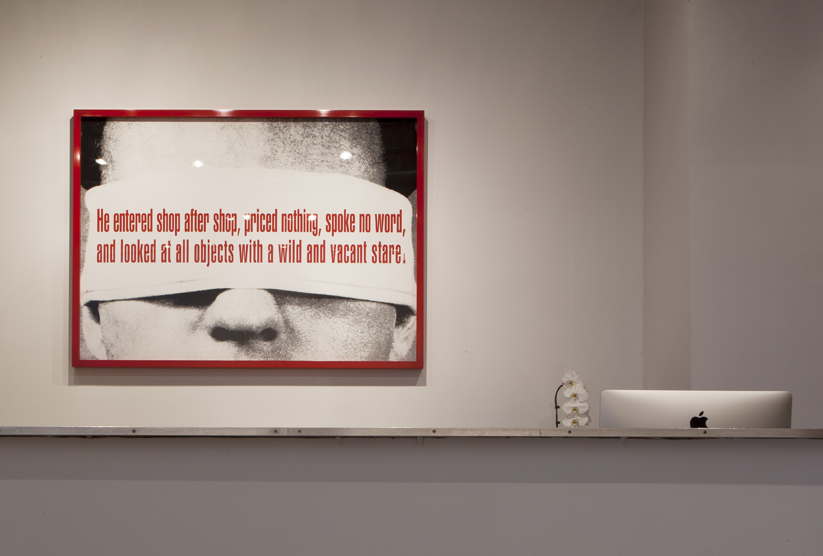
Jacob Hashimoto, Barbara Kruger at Rhona Hoffman Gallery
16 September to 22 October 2016
Included in group exhibition 40 Years/Part 1 at Rhona Hoffman Gallery, Chicago, Illinois.
“40 Years: Part 1” features significant Minimal and Conceptual works like Incomplete Open Cube by Sol LeWitt; a Fred Sandback yarn sculpture; Measurement: Wall (1969) by Mel Bochner; a conceptual ruler drawing and a painting by Sylvia Plimack Mangold; Dan Flavin’s neon light piece; Wolfgang Laib’s Rice House, and two 1960s prints by Donald Judd. Works by Portuguese artist Pedro Cabrita Reis, whom Hoffman first exhibited in the United States, and Barbara Kruger, who executed her first floor text piece in the gallery, are a testament to Rhona Hoffman’s commitment to pushing the boundaries with new ideas. Spencer Finch’s light work Goldberg Variations, new paintings by Art & Language, Michael Rakowitz’s What Dust Will Rise project from Documenta, a hanging sculpture by Richard Rezac, and other recent works buttress the exhibition’s historical pieces...
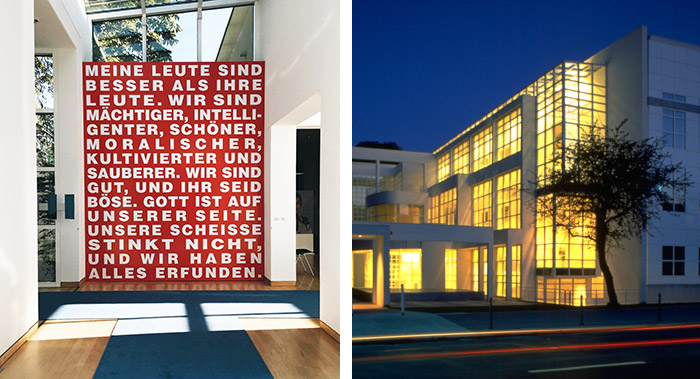
Barbara Kruger at Museum Angewandte Kunst
10 September 2016 to 26 March 2017
Included in group exhibition Under Arms: Fire & Forget 2 at Museum Angewandte Kunst, Frankfurt, Germany.
Whether they are carried – legally or illegally – as a means of maintaining the public order, for the individual or collective application of force, for personal safety or as sports or work equipment, weapons and the threat they pose are always bound up with social structures. They are among us – whether we see them or not, whether they arouse fear or pleasure or both at the same time.
In an exhibition architecture that exaggerates the formal language of fairs for the museum context, the show will present objects from design, the media and art that seek to exploit the emotions associated with weapons for their own aims.
Under Arms: Fire & Forget 2 is an expansion and new conception of the show Fire & Forget: On Violence, curated by E. Blumenstein and D. Tyradellis for the KW Institute for Contemporary Art Berlin...
Barbara Kruger at the Museum of Contemporary Art
16 July to 4 December 2016
Included in group exhibition The Making of a Fugative at the Museum of Contemporary Art, Chicago, Illinois.
In September 1970, Life magazine’s cover featured a photograph of recently arrested scholar and activist Angela Davis superimposed with the words “The Making of a Fugitive.” The exhibition, which takes its name from the iconic publication, presents works that not only reflect on the fugitive figure in American popular culture, but also interrogate how narratives constructed by the media influence our understandings of lawlessness and otherness and directly inform our views on innocence, safety, and normalcy. The artists have combined text and images, self-fashioned themselves as “wanted” bodies, and questioned our ability to accurately interpret visual evidence shaped by multiple social pressures and conditions.
The Making of a Fugitive showcases mixed media, prints, photographs, and sculptures made by artists working from the 1970s to the present and highlights conceptual artworks in the MCA’s collection. Featured artists include Dennis Adams, Chris Burden, David Hammons, R. B. Kitaj, Barbara Kruger, Glenn Ligon, Bruce Nauman, Huong Ngo, Carrie Schneider, and Xaviera Simmons. Whether the works conjure memories of iconic fugitives, such as Patty Hearst and Angela Davis, or incorporate loaded words, like safety and fear, viewers are prompted to question their assumptions about criminality and contemplate how the circulation of images influences their ideas...
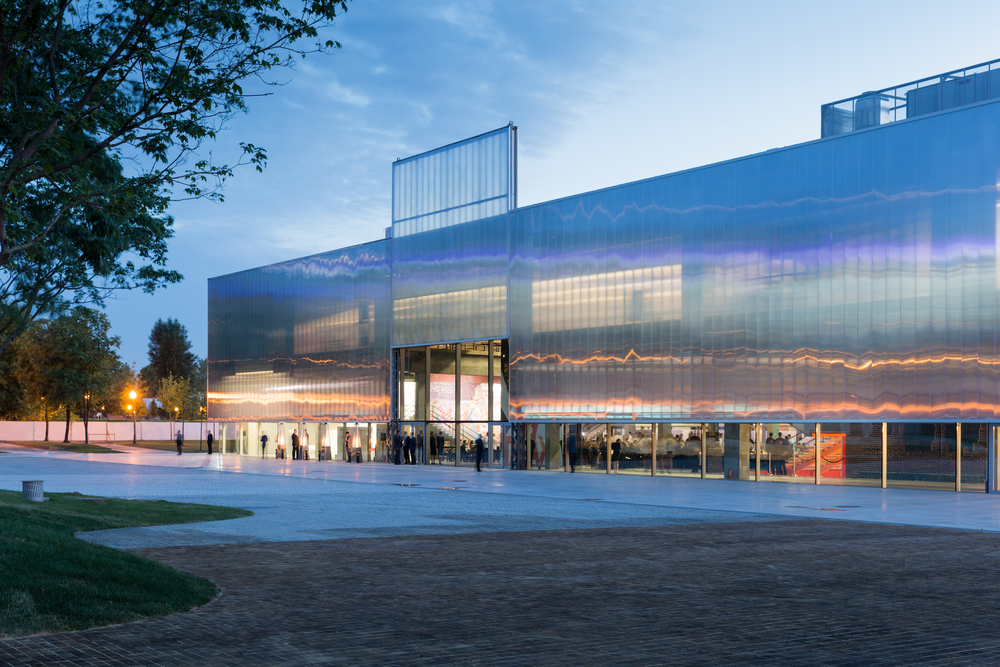
Barbara Kruger at the Garage Museum of Contemporary Art
7 July to 9 September 2016
Included in group exhibition Co-Thinkers at the Garage Museum of Contemporary Art, Moscow.
Co–thinkers is the first in a series of projects at Garage Museum of Contemporary Art that seeks to expand the notion of inclusion in an art institution.
It is also an exhibition of major works by world-famous contemporary artists rarely exhibited in Russia. Artists include Cecily Brown, Maurizio Cattelan, Antony Gormley, Barbara Kruger, John Miller, Melvin Moti, Rob Pruitt, Neo Rauch, Robert Rauschenberg, Jason Rhoades, Ed Ruscha, Jenny Saville, Cindy Sherman, Elaine Sturtevant, Rosemarie Trockel, and James Turrell. The works selected create a perception shift in the viewer’s imagination, stimulating reactions ranging from uncertainty, hesitation, and critique to admiration, irony, and meditation...
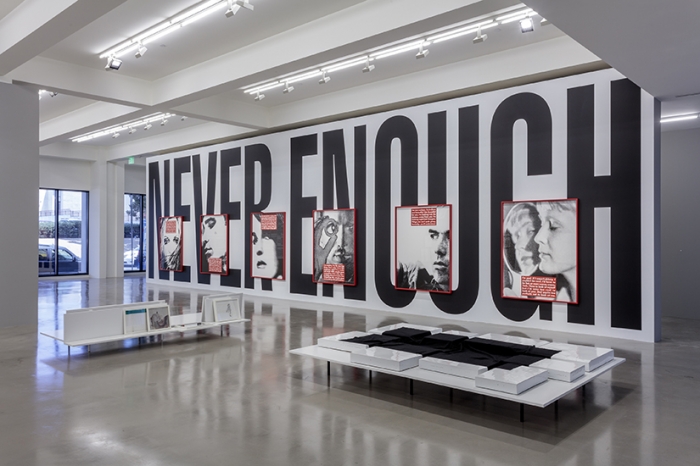
Barbara Kruger at Sprüth Magers
28 June to 20 August 2016
Included in group exhibition Eau de Cologne at Sprüth Magers, Los Angeles, California.
The group show Eau de Cologne at Sprüth Magers in Los Angeles features work from the late-1970s to 2016 by Jenny Holzer, Barbara Kruger, Louise Lawler, Cindy Sherman and Rosemarie Trockel. The exhibition at Sprüth Magers’ recently-opened Los Angeles gallery is a follow-up to its predecessor in Berlin last year. It sheds light on key topics in these artists’ works, but also the specific history of the gallery and its connection to these important female figures of an art that subtly addresses women’s roles in very different ways...

Barbara Kruger in Artforum
Summer 2016
Gatefold cover for Artforum issue on Art and Identity, Summer 2016.
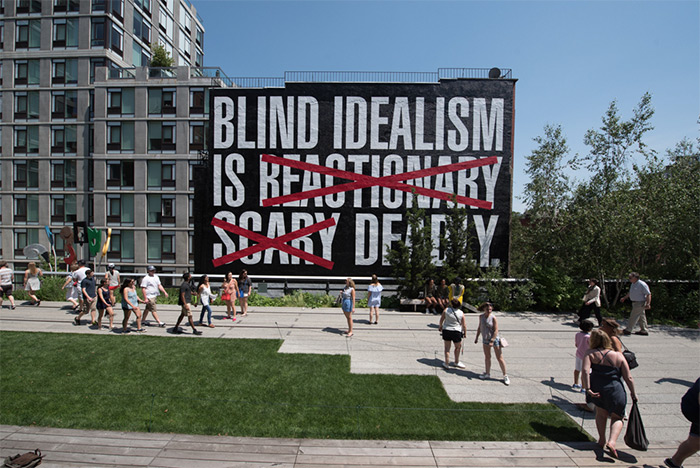
Barbara Kruger at The High Line
21 March 2016 to March 2017
Outdoor mural installation Untitled (Blind idealism is…) for High Line Art, adjacent to The High Line, NYC, NY.
For the High Line, Kruger presents Untitled (Blind Idealism Is…), a new work realized as a hand-painted mural. Continuing her unabashed criticism of culture and power, the mural features the slogan “BLIND IDEALISM IS REACTIONARY SCARY DEADLY,” an adaptation of a quote from Afro-Caribbean philosopher and revolutionary thinker Frantz Fanon, which has appeared in multiple works by the artist. The original statement by Fanon, “Blind idealism is reactionary,” suggests that political and religious convictions stem from the situations from which they grow, not from the inherent nature of individual human beings. According to Kruger, the work reflects “how we are to one another” within “the days and nights that construct us.” These texts, along with Kruger’s own writings, resonate with particular potency in today’s political climate...

Barbara Kruger at The Geffen Contemporary at MOCA
12 March to 11 July 2016
Included in group exhibition Don’t Look Back: The 1990s at MOCA at The Geffen Contemporary at MOCA, Los Angeles, California.
Don’t Look Back: The 1990s at MOCA comprises works from MOCA’s permanent collection that identify the recent decade’s key concerns and transformations, including many that have not been on view since originally shown and acquired. If the 1980s were shaped by the advent of identity politics, producing significant works that examined the nexus of race, gender, and sexuality, the 1990s both extended and challenged these ideas. Many artists turned to large-scale installations as a way to convey a complicated interface between the public and the museum, or to articulate the realms of overlap and dissonance in individual and public identities...
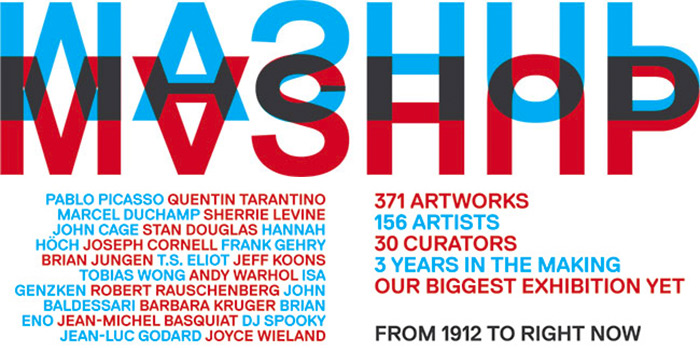
Barbara Kruger at the Vancouver Art Gallery
20 February to 15 May 2016
Major site-specific installation for group exhibition MashUp: The Birth of Modern Culture at the Vancouver Art Gallery, Vancouver, Canada.
From the moment that Pablo Picasso and Georges Braque undertook the revolutionary gesture of adding a rectangle of floral wallpaper, a newspaper headline or a scrap of sheet music to their compositions, they initiated an immediate and fundamental shift in European art.
The resulting explosion of mashup strategies employed across media and movements offers the clearest evidence of the relevance of this process to the growth of visual culture during the 20th century. From Marcel Duchamp to Jean-Luc Godard, Liz Magor to Isa Genzken, artists of diverse disciplines have adopted and reworked this creative strategy. Taking over all four floors of the Vancouver Art Gallery, this groundbreaking exhibition will offer an international survey of mashup culture, documenting the emergence and evolution of a mode of creativity that has grown to become the dominant form of cultural production in the early 21st century.
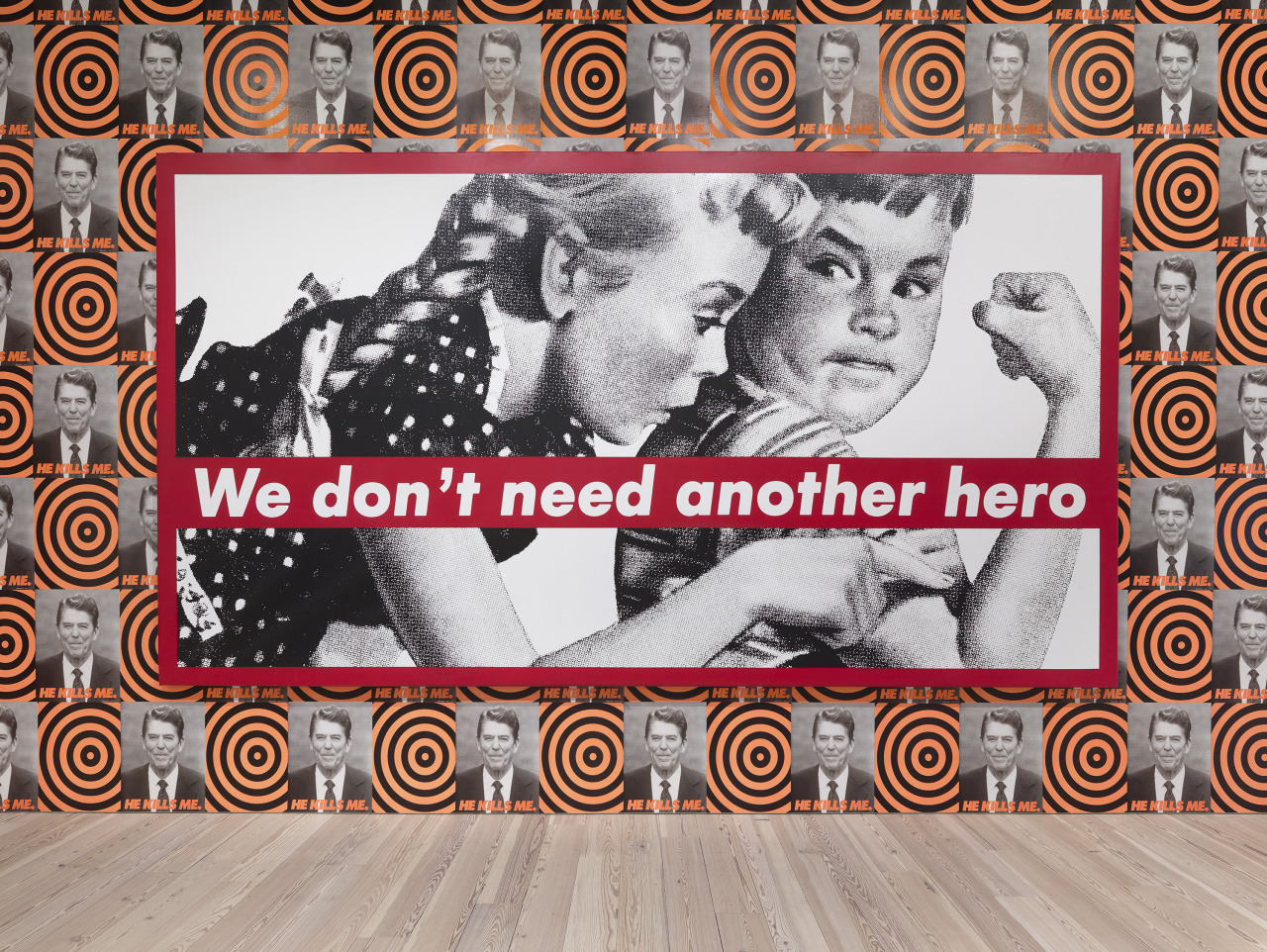
Barbara Kruger at the Whitney Museum of American Art
1 May to 27 September 2015
Included in the inaugural group exhibition America Is Hard To See at the new building of the Whitney Museum of American Art, NYC, NY.
Drawn entirely from the Whitney Museum of American Art’s collection, America Is Hard to See takes the inauguration of the Museum’s new building as an opportunity to reexamine the history of art in the United States from the beginning of the twentieth century to the present. Comprising more than six hundred works, the exhibition elaborates the themes, ideas, beliefs, and passions that have galvanized American artists in their struggle to work within and against established conventions, often directly engaging their political and social contexts. Numerous pieces that have rarely, if ever, been shown appear alongside beloved icons in a conscious effort to unsettle assumptions about the American art canon...

